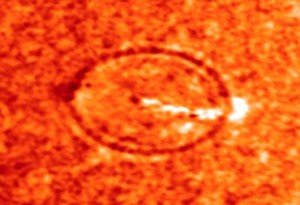
Arquivo para January, 2017
Allies and the bloated community
We continue to comment on Spheres I of Sloterdijk in his introduction.
Explaining the bubble influx, Sloterdijk begins to develop his analysis of modernity from the genesis, exploring the Copernican model that is at its origin, to affirm that it is not by chance that “a series of exploratory ruptures have begun, aimed at an exterior devoid of human beings … “(Sloterdijk, 2016, 22), but which did not cease to” produce discomfort as the infinity of the universe “(idem) reflection of the astrophysicist Kepler, protesting the model of Giordano Bruno “there is a non-know -that of terrifying and hidden. “
The image of an explosion on the surface of the Sun, larger than Earth illustrates this passage.
The author also quotes the English physicist and cosmographer Thomas Digges, who in the 1570s had already proved that the theory of the celestial layers was unfounded and “also the calculating image that the Earth was surrounded by spherical vaults” (page 23) Was wrong, but as I said in Pascal’s phrase: “the eternal silence of infinite spaces terrifies me,” and the machinic and rationally explained world was advantageous to the Enlightenment.
It then develops the deliberate greenhouse effect, where its “lack of space wrappings through a civilized artificial world … this is the ultimate horizon of Euro-American technical titanism” (page 25).
After criticizing the policies of progress and ecological destruction, he writes: “In order to make room for the substitute artificial sphere, the remains of a faith in the inner world and in the fiction of a security are exploded in all regions of the old world. The name of a radical market enlightenment that promises a better life, but which, in a first moment, only devastates the immune norms of the proletariat and the peripheral populations “(page 27).
He emphasizes the importance of the ontological resumption and that this is the concern of more contemporary philosophers: “The popular plan of forgetting oneself and the Being operates through a mocking disregard for the ontological situation” (page 28).
Before turning to criticism of idealism and a rereading of Christianity, he points out on page 29 what is the center of the book: “As dwelling always means to constitute spheres, smaller or greater, men are creatures who establish circular worlds and look on Direction to the exterior to the horizon. “
SLOTERDIJK, Peter. Spheres I: bubbles. São Paulo: Estação Liberdade, 2016
The inflated community
The book in the Brazilian translation of Sphere I – Bubbles, here in 2016, in Germany in 1998 (Spheren I: Blasen), talks about the Introduction of inspiration for bubbles, but the whole title is: THE ALLIES or the Inspired Community (the capital letter is Of the author), but I reversed the analysis to follow as the author writes.
in 1998 (Spheren I: Blasen), talks about the Introduction of inspiration for bubbles, but the whole title is: THE ALLIES or the Inspired Community (the capital letter is Of the author), but I reversed the analysis to follow as the author writes.
The title has several spherical inspirations, but the most important is the G.H. Every, from 1887, Bubles, an oil painting of Sir John Everett Millais (1829-1896), where the author speaks of the oval balloon made by his “insufflator” and in the time that of life of a bubble, accompanies the life that Let it escape until it burst “at the same time a sigh and an exclamation of jubilation”.
The bubble, the object created, and its “insufflator, there is a solidarity that excludes the rest of the world” (Sloterdijk, 2016, p.20), and “exist together in a field strained by attentive sympathy.”
But gradually he outlines the purpose of this metaphor, “the child who follows his soap bubbles in the open space is not a Cartesian subject clinging to his or her locus of thought without extension, to observe an extensive thing in its trajectory in space” (ibidem) , In a clear reference to the Cartesian dichotomy between the thing and the extensive thing (res extensa).
Thus raises his first questions: “and what happens to who is not the breath of anyone? Every life that emerges is individualized, is it as such contained in a sympathetic breath? “(Sloterdijk, 2016, 21), the author goes to Schopenhauer’s question:” is it legitimate to think that everything that exists and is thematized would be wrapped in the care of somebody? ” (Idem).
The question you are asking is a reference to Heidegger: what do we mean when we say we are in the world? But it actualizes and reformulates it using the question of necessity: “In fact, necessity is known (Schopenhauer called it the metaphysical necessity) that everything that belongs to the world or to the being as a whole is contained in a breath, as In an indelible sense. Can this need be fulfilled? Can it be justified? “(Sloterdijk, 2016, 21).
Before arriving at the central point of its outline, modernity will ask the question which is a direct reference to Ludwig Wittegestein’s Logical-Philosophical Treaty: “Who first conceived the idea that the world would be absolutely nothing more than the soap bubble Of a breath that encompasses everything? What exterior would belong, then, all that is the case? “(Idem).
The question of modernity and its allies is outlined, which is why I left it for later.
SLOTERDIJK, Peter – Esferas I: Bolhas, Ed. Estação Liberdade, 2016. (Brazilian edition).

